News From the Festival
Witches in Utah
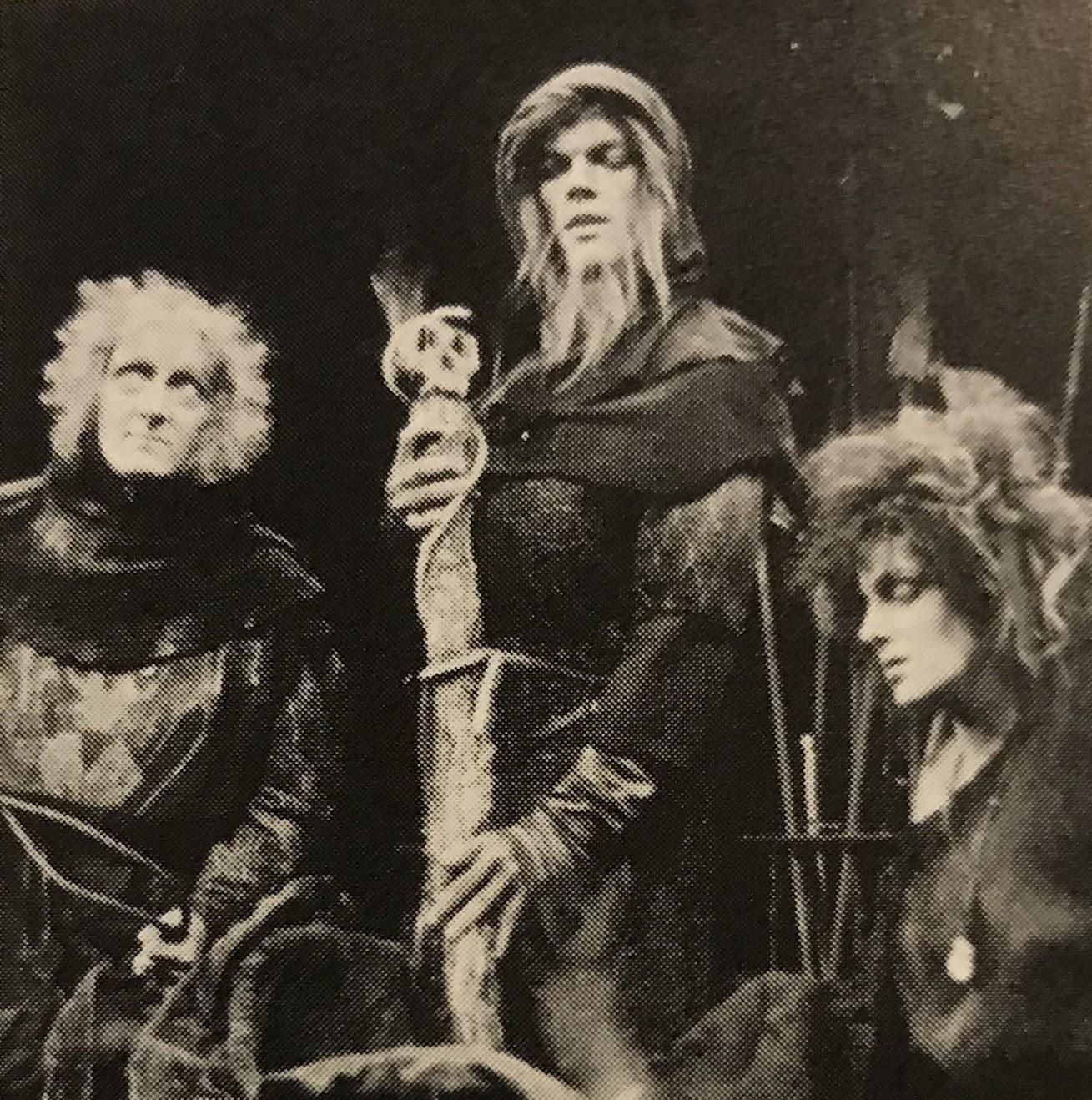
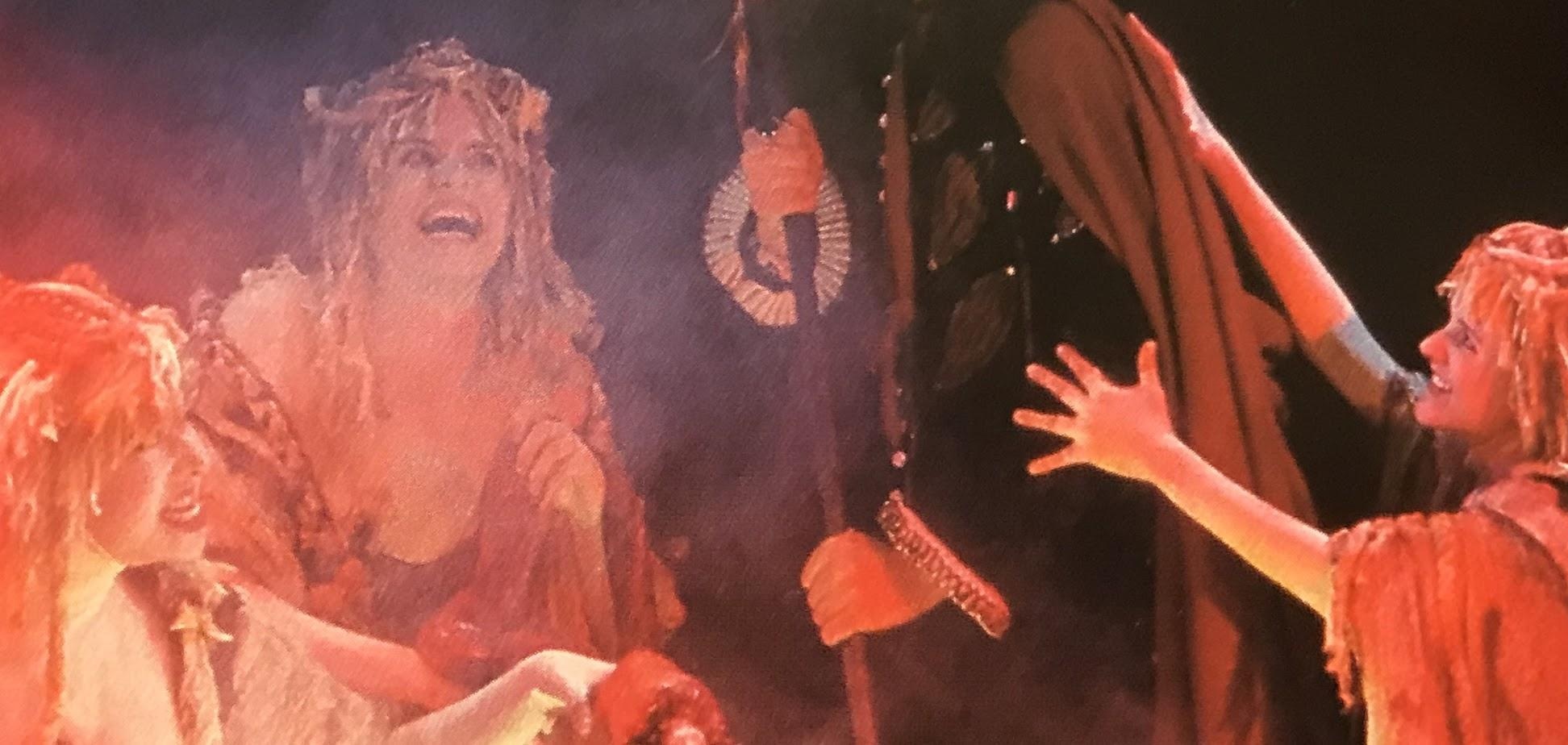

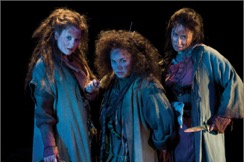
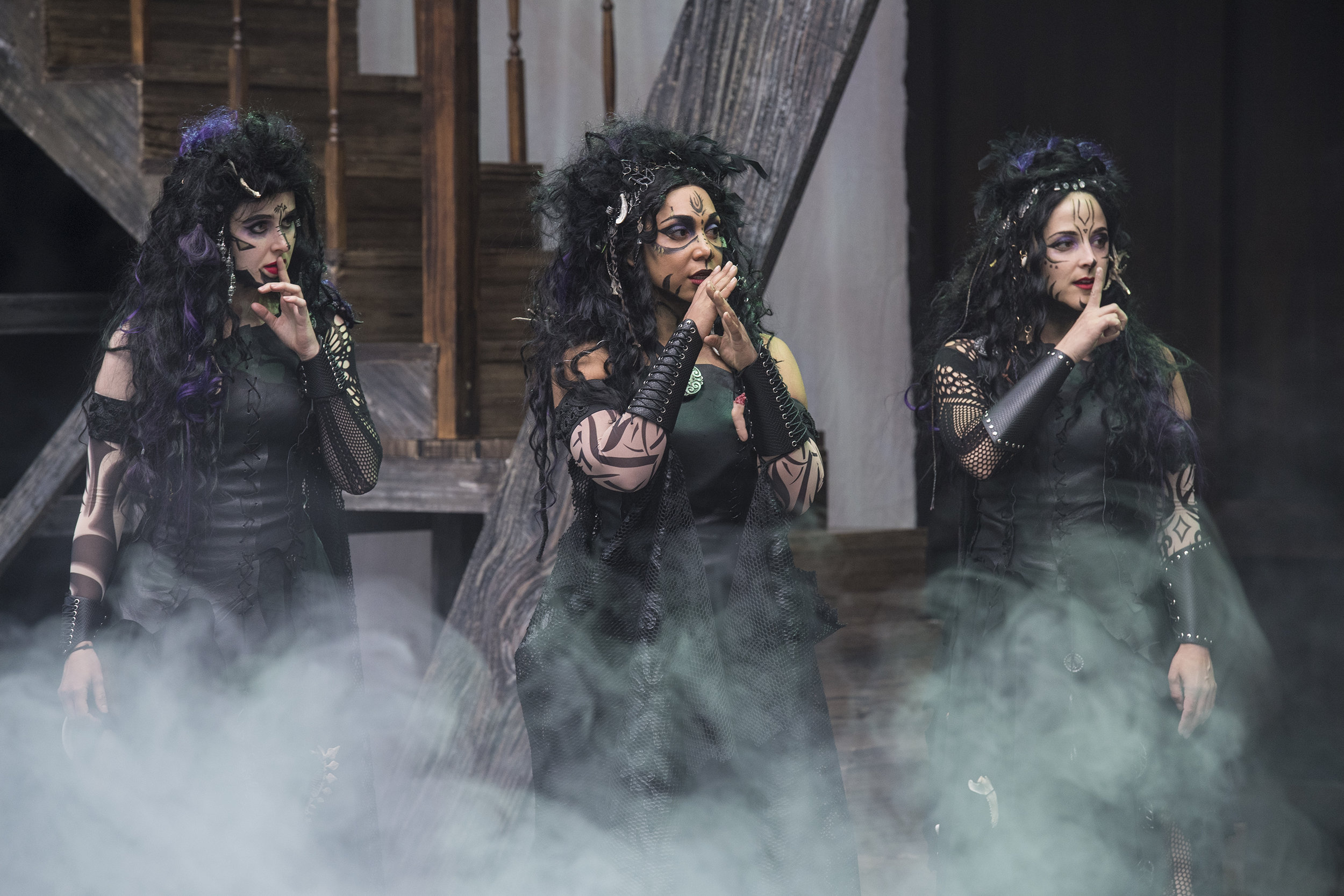
1989
1996
2004
2010
2019
By Kathryn Neves
“Double, double toil and trouble; fire burn and cauldron bubble. . . . By the pricking of my thumbs, something wicked this way comes.” These are the words that ominously echo whenever we think of witches. I mean, it’s even in Harry Potter. Definitely, Shakespeare’s witches are among literature’s scariest, and most fascinating, characters.
Macbeth has been produced at the Utah Shakespeare Festival seven times, the 2019 production being the eighth; with all that, there have been some pretty interesting witches on our stages. Take a look at a few of the ways that Macbeth’s demons have been portrayed throughout the years:
In 1989, the witches were so ominous that even pictures are frightening. Look at the beard there; clearly, the designer wanted to be as close as possible to Shakespeare’s words. “You should be women, and yet your beards forbid me to interpret that you are so” (1.3.47-49). Portraying the witches here are Laurie Birmingham, Amy Thone, and Doug Zschiegner.
Up next, in 1996, we have a trio of witches that have clearly embraced every aspect of their dark side. Their ragged costumes and hair and the sinister props, not to mention the deep red lighting and the terrifying facial expression, all point to witches operating on a plane far more terrifying than our own. Actors here are Erin Annarella, Manon Halliburton, and Kari Hayter.
The witches of the 2004 production of Macbeth are dark, sinister, and gruesome. Their makeup makes them look deathly, as though they’ve come back from the grave to torment Macbeth. The use of blood and frightening symbols made these witches’ performance absolutely unforgettable. Witches were portrayed by Misty Cotton, Pat Sibley, and Afton Quast (with Henry Woronicz as Macbeth).
And lastly, in our most recent 2010 production, these witches look wild. They look as though they live in the wilderness, waiting to prey upon susceptible people like Macbeth. Their tangled hair and matted clothing all point to their roles as creatures of another world. Their frightening demeanor and poses are threatening, even in picture form. These witches are portrayed by Chelsea Steverson, Lillian Castillo, and Monica Lopez.
The witches in 2019 are portrayed by Emma Geer, Sarah Hollis, and Betsy Mugavero. They are supernatural and chilling, mysterious and otherworldly. They are gritty and dark and . . . well, you need to come and see for yourself.
King James I and Macbeth

By Kathryn Neves
It’s commonly held that Shakespeare wrote his plays for the monarchs of England. There are many stories, mostly apocryphal, that connect this play to that monarch; for example, one popular story says that Queen Elizabeth, upon learning that John Falstaff dies in Henry V, demanded that Shakespeare write a new play for Falstaff, one in which he falls in love— resulting in The Merry Wives of Windsor (whether or not this is a true story, it’s definitely entertaining). But there’s one play that was clearly written with a monarch in mind. Shakespeare’s Macbeth was pretty obviously a nod (and not a subtle one) to King James I.
There are a lot of reasons to say this. For one thing, the play is entirely set in Scotland, based on Scottish history and legend, and populated with Scotsmen. James I of England was actually from Scotland as well; he ruled over both England and his own home country, where he was called James VI. Though there are other Scottish characters in Shakespearean plays, there are none with so many as in Macbeth.
Then there’s all the supernatural elements. James I was an avid scholar of all things strange, weird, and superstitious. In 1597, the king published a book called Daemonologie; it was a study of witchcraft, necromancy, demons, werewolves, vampires, and all sorts of other spooky things. In fact, much of the witchcraft in Macbeth was actually taken directly from Daemonologie, probably as a form of flattery to the king himself. It goes further than that, though. Witchcraft seems to have been a real obsession of James, as he was heavily involved in a series of witch trials in 1590. Supposedly, a coven of witches were trying to personally attack him, which was high treason, so James had them tracked down, forced them to confess to witchcraft, tortured them, and had them burned at the stake. So it’s no wonder that the witches in Macbeth are so demented and evil! Shakespeare wanted to make it clear that he was on the king’s side in the whole witch debacle.
King James was widely considered paranoid (can you tell from the witch thing?). Throughout his whole reign, he was terrified that he would be assassinated. He was very harsh with treasonous criminals and he constantly seemed to fear usurpation. And to be fair, he had some real reasons to be afraid of all of that. When Queen Elizabeth I died, she left no children behind, which meant England fell into a crisis. The English throne only came to James because he was technically the closest relative. Even so, Elizabeth never formally acknowledged him as her heir, so he never felt fully secure on the throne. Not only that, but Elizabeth had executed his mother years before, so he had more reason to fear the English. In 1605, James uncovered an assassination attempt against him: the Gunpowder Plot. The plan was for a group of dissatisfied Jesuits to blow up the House of Lords when James was there. After discovering the plot, James arrested and executed the conspirators. The whole incident only served to feed the fire of his paranoia.
Because of the Gunpowder Plot, most scholars today date Macbeth to 1606, just after the plot. There seem to be a few references to it in the play: for instance, the porter at Macbeth’s castle, in a little joke to himself, says “Knock, knock! Who’s there, in th’ other devil’s name? Faith, here’s an equivocator, that could swear in both the scales against either scale, who committed treason enough for God’s sake yet could not equivocate to heaven. O, come in, equivocator” (2.3.7-12). Equivocation, which is both lying and telling the truth at the same time, was used as a defense by one of the conspirators at the Gunpowder Plot trial, so Shakespeare could easily be alluding to that in order to get further into the king’s good graces (Globe Research Team, “The Gunpowder Plot and Shakespeare’s Macbeth,” Shakespeare’s Globe Blog, November 5, 2014).
Besides that, Macbeth is full of other references to James’ fears. King Duncan, a beloved, good king, is assassinated by one of his noblemen— something that seems to have been a great fear for James. Not only that, but the nobleman was consorting with witches and demons— another fear. So Shakespeare punishes Macbeth for his treason and evil behavior in the play; Macbeth himself becomes increasingly paranoid, he gets haunted by the ghosts of those he’s wronged, and he ends up beheaded and hated by all of Scotland. Shakespeare wanted Macbeth to get his just desserts so that James would be appeased.
Scottish history and legend contain a real life King Duncan, who was really murdered by Macbeth (the real Macbeth apparently was a decent king— that wouldn’t have really worked for Shakespeare’s play though). Banquo, too, was apparently a real figure. King James claimed descendance through him, so in Macbeth, when the Weird Sisters tell Banquo that “thou shalt get [beget] kings, though thou be none,” Shakespeare was really trying to help legitimize James’s place on the Scottish throne— he was saying that Banquo’s descendants deserve to be king, therefore James has a rightful claim to the throne.
Even though Macbeth was written for King James I, it’s really for all of us. The themes of triumph over evil, of greed and ambition, and of tyranny are all very important— they were relevant in Shakespeare’s day, and they’re relevant now. The reasons it was written aren’t nearly as important as the words themselves. So don’t miss your chance to see Macbeth this summer at the Festival. It’s bound to be an amazing experience.
What the Heck Is a “Twelfth Night”?

By Kathryn Neves
There are a lot of Shakespearean comedies, all of them incredibly fun and exciting. But perhaps none is so well-beloved as Twelfth Night. It’s a staple of school performances, it’s been adapted into a movie (She’s the Man, anyone?), and it’s always been very popular with Utah Shakespeare Festival audiences. What’s not to like? It’s well-written, lighthearted, and fairly easy to understand. And yet, there’s one thing about it that absolutely baffles most people—why is it called that? What is a “twelfth night”?
Well, the answer to that question goes all the way back to the birth of Christ. That’s right. Twelfth Night is a Christmas play. You see, Shakespeare probably wrote the play for a Twelfth Night celebration. (The fact that the play’s plot has little-to-nothing to do with the holiday is neither here nor there.) Twelfth Night was a holiday usually celebrated the twelfth day after Christmas: January 6. (Is that where “The Twelve Days of Christmas” song came from? Yes. Yes it is). Though Twelfth Night is not really celebrated anymore, it was always a huge part of Christmastide celebrations in Elizabethan England. Originally, it marked the Epiphany: according to Christian tradition, the revelation of God as Jesus in the flesh. It also commemorated the Magi’s visit to the Christ child.
Now, Twelfth Night festivities were not your grandma’s Christmas parties. They were hugely raucous and full of drinking and mischief-making. One tradition was for men to dress up as women, and women to dress up as men, and for servants and masters to switch roles for a short time. It’s no wonder, then, that both of these themes appear in Shakespeare’s play. It also explains why Sir Toby Belch, Sir Andrew Aguecheek, and Feste are such important parts of the show; their drinking and revelry match all the contemporary twelfth night celebrations. Also, we can see Malvolio try to play master rather than servant all throughout the play, and, of course, Viola’s cross-dressing fits right into Twelfth Night festivities.
There were even stranger traditions present in Tudor Twelfth Night celebrations. One particularly odd one involves a cake, a bean, and a pea: the vegetables were baked into the cake, and the man who found the bean became king for the night while the lady with the pea became queen. But, if you want more traditional Christmas traditions, they’re part of the celebration also. Twelfth Night was a night of feasting, caroling, and wassail-drinking. It was the last night of Christmas, after all. Elizabethans wanted to send the holiday off with a bang.
Knowing all this, we can pretty safely assume that Shakespeare wrote Twelfth Night for the holiday festivities—even though the first recorded performance was on Candlemas, nearly a month later. It’s still possible it was performed earlier, or just written with Twelfth Night in mind.
Either way, this all technically makes it a Christmas story (I’m so ready for the Hallmark Holiday Twelfth Night special; I can see it now). So this winter, bundle up next to the fire with a cozy cup of cocoa and a plate of cookies; and while you wait for Santa, pull out your copy of Shakespeare’s Twelfth Night. Or— maybe not. Instead, come and see it this summer at the Utah Shakespeare Festival. After all, who doesn’t like a little Christmas in July?
Shakespeare's Twins
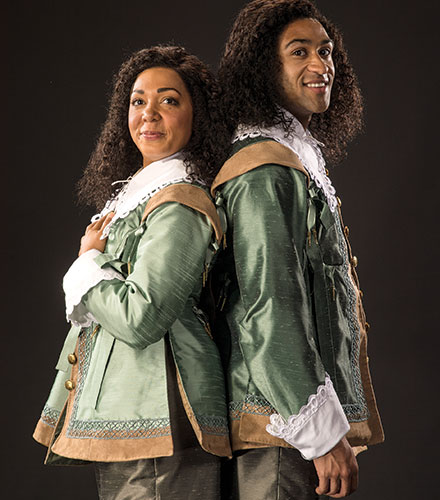
Sarah Hollis (left) as Viola and Tristan Turner as Sebastian in Twelfth Night*.*
By Kathryn Neves
Ask any writer, and they will tell you: writers reuse ideas. I mean, why not? If something works and works well, then why give it up? As the old adage goes, if it ain’t broke, don’t fix it. Even Shakespeare, who is arguably the greatest writer in the English language, recycled his (and others’) old ideas. Look through his plays and you’ll see common themes running through them. Shipwrecks are pretty common. Then there’s a lot of ghosts in his plays. And of course, mistaken identities are huge. One recycled idea that is particularly entertaining is twins. Shakespeare loved twins. Two of his most major, and most popular, comedies center around twins. The Comedy of Errors, one of his early comedies, is about two sets of identical twins and a farcical mixup. The other is one of the plays the Utah Shakespeare Festival is producing this season: Twelfth Night, about a shipwrecked pair of twins who are separated and end up causing all sorts of mayhem in Illyria.
As far as recycled concepts go, it seems that Shakespeare held back quite a bit with the whole twin theme. There’s really only two plays that contain twins of any kind, and only three sets of twins in total. But the fact that the characters’ “twinhood” is so prominent in the plot of the play suggests that Shakespeare was pretty obsessed with twins. Other repurposed motifs might show up, but they’re not at the crux of the plots. You might see a Shakespearean ghost fairly often, but usually the ghost is only in a couple of scenes and the plot revolves around other things. Same goes for shipwrecks and smothering people with pillows. But The Comedy of Errors and Twelfth Night would absolutely not work if it weren’t for the twins. Twins are at the heart of each of these plays.
Why did Shakespeare like twins so much? It’s hard to say. We know so little about the man himself that most of what we can say is just an assumption. Still, a lot of these assumptions are pretty safe, including the fact that Shakespeare had three children, two of whom were fraternal twins— so we can assume that this is one reason the whole twin concept was so important to him.
Shakespeare’s twins, Hamnet and Judith, were born in 1585, probably before Shakespeare had written and published any of his plays. We don’t know a lot about the twins, but we do know that Hamnet died very young— he was only eleven years old when he caught what was probably the bubonic plague. He died just a couple of years after the premiere of The Comedy of Errors. So it’s possible that Shakespeare wrote about twins because he was the father of twins.
There are differences between the twins in The Comedy of Errors and Twelfth Night. In the former, there are two sets of fraternal twins. This is played more for farce than for any sort of emotional impact or resolution; in fact, even though the twinhood is celebrated in this play, it’s also the problem. The play is only resolved when the other characters are able to separate and make distinctions between all four twins. Twelfth Night, on the other hand, plays the whole twin idea more seriously. Don’t get me wrong; it’s still a comedy. But it’s a comedy with some sad undertones.
The play starts with a shipwrecked and distraught Viola learning of her twin brother Sebastian’s supposed death. In fact, she believes that Sebastian is dead throughout most of the play, and only finds out that he is still alive at the very end. This theme of separated and dead twins was probably close to Shakespeare’s heart; he wrote the play only around five years after his son’s death, so it’s no surprise that a dead twin is a prominent part of the plot. The twins in Twelfth Night are fraternal, just like his own children.
In Twelfth Night, it’s only through the “twinhood” of these characters that there’s any resolution at all. If Viola and Sebastian were not twins, then Olivia would end the play alone and with unresolved romantic feelings for Viola. Instead, she pairs off ultimately with someone very similar in appearance and personality, and Viola has her own love and her own life. If Sebastian was not Viola’s twin, the plot would not resolve nearly as happily or as tidily. The Comedy of Errors is all about the problems with being twins, while in Twelfth Night the twins are what make a happy ending possible.
Even with these differences though, The Comedy of Errors twins and the Twelfth Night twins are similar; both sets of twins are treated like heroes. They are the protagonists, they are normal people, and they all seem relatively happy. This was wildly different from what other writers did at the time. If twins featured in any literature at all in Shakespeare’s day, it was usually in the context of something tragic or something unnatural. Contemporary scientific thought held that twins were unnatural and deviant, born out of unnatural desires in the mother (Daisy Garofalo, “Shakespeare’s Twins,” Welcome Library, 25/04/2016).
It seems that Shakespeare was a lot more forward thinking when it came to twins than his colleagues and contemporaries. Shakespeare’s twins are not unnatural, they are not deviant, they are not weird. Instead, his twins are individuals with their own strengths and faults, and their twinhood is secondary to their own personal characters. This might be because he understood better, as the father of twins. Or it could be that he was just better educated on the subject. Or maybe, Shakespeare just knew the human condition and understood individual characters in a unique and deep way.
Regardless of the reasons, Shakespeare’s twins are complex and entertaining, and they make for some great theatre. So come see Twelfth Night this season and see the twins for yourself. You might get a better understanding of Shakespeare’s writing in general. And— most important— you’re sure to have a good time.
The War of the Roses in a Nutshell
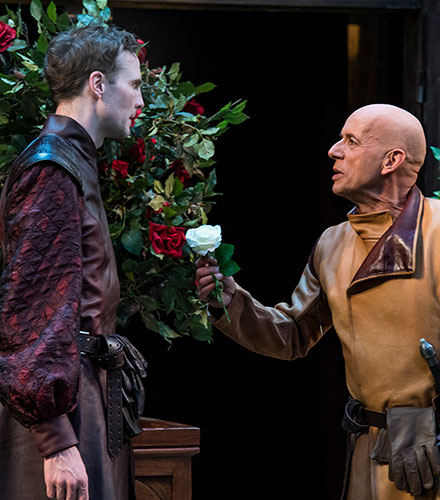
Lance Rasmussen (left) as Earl of Somerset and Michael Elich as Richard Plantagenet in Henry VI Part One, 2018.
By Kathryn Neves
As exciting and full of intrigue as the Henry plays are, they can be hard to follow. They’re full of historical references and allusions that are far removed from our time. If you don’t know the history, Henry VI can be challenging. Shakespeare’s audiences certainly understood the plays. Even though the War of the Roses took place a few centuries before Shakespeare’s day, Elizabethans were still under the effects of the War of the Roses. The whole Tudor clan, including Queen Elizabeth, came to power because of that war. So the history was relevant and accessible to them.
We might need a little more context, though. So here is the in-a-nutshell version of the War of the Roses, as it applies to all three parts of Henry VI.
It starts, as the name implies, with two roses: one red and one white. The red rose was the badge of the House of Lancaster, and the white rose was the badge of the House of York. In Henry VI Part One, Shakespeare used actual roses as symbols for each house and for each side of the argument, but in reality, it had nothing to do with the actual flowers. There wasn’t a picking-of-the-roses scene; it was just a symbol of their houses.
Henry V (red rose), one of England’s favorite kings, tenuously won control of France and married a French princess: Catherine of Valois. Because of this, he declared himself the king of both France and England. So, when his son was born, the baby was declared the heir. Henry V died nine months after the birth of his son, and the crown passed on to the infant. Obviously, though, a baby can’t rule a country; so little Henry VI’s uncles became regents of the realm and ran the country in his place. Things were tense, but it seemed like things would get better as soon as little Henry grew up.
Unfortunately, that wasn’t the case. Henry VI was not interested in politics: he was quiet, he was weak-willed, and his wife had far more ambitious plans than he ever did. Not only that, but Henry inherited a mental infirmity from his grandfather, the old king of France. So with all that going on, there was no way Henry could effectively rule. He ended up losing France, which angered the English people and paved the way for a new contender for the throne: Richard, the Duke of York (white rose). York was a direct descendant of King Edward III, and as such had a strong claim on the crown, some say stronger than Henry’s claim. Still, Richard declared loyalty to Henry and decided to wait until Henry died, then take the throne. Unfortunately for him, Henry’s wife, Margaret, had a son and heir. At this point, Henry briefly seemed to recover from his illnesses, and sent Richard away. It was then that Richard of York decided that the time was now, and he moved against Henry.
After numerous battles, the Yorks won, took King Henry prisoner, and established the new monarchy under the white rose. Meanwhile, Margaret of Anjou (Henry’s wife) raised up an army to try to reinstate her husband on the throne. And yet again, the Yorks won.
Margaret kept trying to reinstate Henry to the throne, and York kept trying to capture Henry. Finally, Henry and Richard of York came up with a compromise: Henry could stay king, but Richard and his family would be his heirs. Margaret didn’t like this at all, and once again raised an army against the Yorks. This time, things were different, and the Yorks were soundly defeated. Margaret had Richard killed, and his severed head was put on display, putting the house of the red rose firmly in charge again.
However, Richard also had a son, Edward, and Edward marched against the Lancaster group (Henry and Margaret, if you remember). The battles seemed to go back and forth, but eventually the Yorks won, and Edward of York took the throne for himself—back to the white rose.
Margaret wasn’t done, however; she fought against Edward and put her husband right back on the throne he’d just been kicked off (now the red rose again). In retaliation, Edward gathered another army and led several more battles against the Lancasters. Henry and Margaret were defeated, Henry died, and Margaret eventually went back to France (and the throne is firmly in the hands of the Yorks, the white rose).
This is where Henry VI ends; the story keeps going, however. Edward of York, now Edward IV of England, ran the country for a while and then died, giving the crown to his son— Edward V. But Edward IV’s brother, Richard, didn’t want that; he wanted the throne for himself. He plotted to have the boys declared illegitimate and placed in the Tower of London— and was soon crowned Richard III.
All of this, though, led to Henry Tudor— a distant relative of Henry VI— defeating Richard III and taking the throne for himself, as Henry VII. He quickly married Elizabeth of York and they had a child who would become Henry VIII, with blood in his veins of both the house of York (white rose) and the house of Lancaster (red rose), finally uniting the two families and ending the War of the Roses. And, of course, one of Henry VIII’s children was Elizabeth, who would become Queen Elizabeth I, Shakespeare’s queen and possibly his patron.
There’s a lot to unpack here, but that’s a quick glimpse of the War of the Roses and the history and context. Hopefully this will help you to understand the play a little better. But even without all these details, you should see the play: it’s full of tyranny, political intrigue, and crazy family dynamics that everyone can understand, whether they’re an Elizabethan peasant or a present-day office worker.
A Two-for-One Spectacular

Jim Poulos as King Henry VI in Henry VI Part One, 2018.
By Kathryn Neves
For the first time in the history of the Utah Shakespeare Festival, audiences will get to experience not only a sweeping epic of warfare and intrigue, but can view two shows for the price of one: all a part of this season’s production of The Conclusion of Henry VI: Parts Two and Three.
The last two parts of Shakespeare’s timeless Henry VI will be produced together this season, performed one after another in a two-in-one viewing. Each part will run for around two hours, with a thirty-minute intermission between them. And the best part? You can see both shows for only one ticket.
“I was intrigued with the idea that Festival audiences would have the opportunity to see both parts played out in a single viewing, keeping the serial nature of the work more immediate and helping the viewer digest the arc of the story in a more profound way,” said Brian Vaughn, artistic director. “Most of our productions are trimmed or cut, even the comedies, and that includes this production. However, this is still both plays, still Shakespeare’s characters. Still Shakespeare’s plot.”
This production is the latest installment in the history cycle, the Festival’s plan to produce all ten of Shakespeare’s histories in chronological order. In addition, this will be the first time at the Festival that the plays will be performed as separate shows, rather than a combination into one play. (In 2000 the Festival produced all three of the Henry VI plays in one adapted version, The War of the Roses.) Guests participating in Complete the Canon will be able to check both plays off their list this year!
In addition, The Conclusion of Henry VI: Parts Two and Three will be performed in the Anes Studio Theatre. “Shakespeare works in all kinds of theatre facilities. One reason the Festival wanted to build a studio theatre was to enable us to do Shakespearean performances in a small theatre setting, said Frank Mack, executive producer. “The Anes Theatre will make for a very intimate performance style of these plays. . . . This kind of variety is one of the things that makes visiting the Festival so unique.”
“Like our recent Anes productions of Othello and Julius Caesar, by performing The Conclusion of Henry VI: Parts Two and Three in the studio, audiences will be thrust into the heart of the action, and the play can sweep over them in a way that is more visceral and immediate than the grand, outdoor Engelstad Theatre,” explained Vaughn. “The intimate nature of the theatre is in harmony with the intimate nature of the plays and puts the audience in the same room as the characters, allowing them to see, feel, and experience the play in a completely different way than they had imagined.”
Parts two and three of Henry VI are among the least performed of Shakespeare’s canon, so this season’s production of each of them will be a rare, exciting, and unique experience. “These plays are full of intrigue and fascinating history, but there is also a lot of warfare,” said Mack. Vaughn added that “audiences can expect a sweeping, engaging, thrilling production in an intimate setting, featuring amazing actors and engaging storytelling.”
The Conclusion of Henry VI Parts Two and Three will run from June 29 through August 31. For tickets and more information, call 1-800-PLAYTIX or visit www.bard.org.
Be Part of a Unique Theatrical Experience

Costume design by Lauren T. Roark
By Kathryn Neves
Have you ever been part of a show? I don’t mean as an actor, or a director, or a technician. Have you ever been in the audience and been a part of the show itself?
We see it all the time. Audience members pulled onstage from their comfortable seats, thrust into the limelight of the stage for a few minutes, then returned to their perch to watch the show. It’s in a lot of plays, and really fun ones too; Forever Plaid does it, The Complete Works of William Shakespeare (Abridged) does it— we even do it in The Greenshow sometimes. It’s a lot of fun for everyone involved, and creates fun memories that will last for years to come.
Every Brilliant Thing, though, is different. The audience isn’t just part of the show; they aren’t just there for a scene or two, then gone. No, the audience for this show is as important to the production as the actor himself.
From the very beginning, Every Brilliant Thing is different. This isn’t a play you just sit back and watch. Instead of an actor onstage reciting soliloquies and speaking monologues to the open air, the actor speaks to you. To us. Right away, that traditional fourth wall is broken. There’s just no such thing in this play.
Every Brilliant Thing is the story of a young man dealing with the repercussions of his mother’s drastic actions. The Storyteller, the only character in this one-man play, tells us all the ups and downs of his life. He tells us about his dog, his marriage, and, most importantly, his relationship with his suicidal mother. But this isn’t just a one-way conversation. No, the audience steps in. Various audience members become therapists, vets, lovers, professors; they answer back to the Storyteller’s questions and concerns. The audience is a character in this play.
Why would a writer do that? Why would a playwright, who is well aware of the rules and conventions of the theatre world, deliberately destroy the fourth wall and put so much responsibility on the audience?
The truth is, theatre is about much more than sitting down and watching a play; it’s about more than entertainment. That isn’t to say that entertainment value isn’t important. After all, would we still watch and enjoy Shakespeare’s plays if they weren’t at least nominally entertaining? But theatre goes deeper than that. Theatre is about people. It’s about very human emotions and actions, and it’s about relationships. Mostly, theatre is about community. It’s about coming together as people and sharing a beautiful, moving experience. As audience members, we react together: we cry at Juliet’s tragic death, we laugh at Bottom’s bumbling idiocy. We feel the pain behind every Laura Wingfield, and we savor in the romance between Tony and Maria. Even though the characters are only figments of our imagination and the inventiveness of the actor, we connect with them in a very real way.
In Every Brilliant Thing, we have a bigger chance to do that than we do watching other plays. We get to be a part of the experience, and we get to share in the joys and sorrows of a young man’s life, not only with each other, but with the character himself. By the end of the show, we get to feel like a real family— a family of audience members and actors, of theatre lovers, of people.
In the end, Every Brilliant Thing is really a one-of-a-kind theatre experience. Every night is a different show, with different people and different characters; each night, the list of brilliant things changes and evolves with the people who watch the play. But what doesn’t change is what really matters: the celebration of life and of people. What an amazing experience to be a part of!
Everything You Need to Know

Artwork by Cully Long
As one of eight plays at the Utah Shakespeare Festival this summer, Every Brilliant Thing fits in nicely with all the others. Like Hamlet, one of its themes is the possibility of suicide, but in Every Brilliant Thing it is the main theme. Like many of the plays this season (especially Macbeth, The Conclusion of Henry VI: Parts Two and Three, and The Price), it reveals the angst that sometimes is just below the surface in family relationships. And, like Joseph and the Amazing Technicolor Dreamcoat, Twelfth Night and The Book of Will, it is warm, humorous, and embracing.
It is also different in many ways: Scheduled for the intimate Eileen and Allen Anes Studio Theatre, it is a one-man show, full of audience participation. And it stars and is directed by an actor and a director whom Festival audiences will fondly remember and who also have a great deal of respect for each other.
The Festival recently posed a series of questions to director Vincent J. Cardinal and actor Michael Doherty as they prepare to return to Cedar City in a couple of weeks and begin work on this amazing play. We think you will find their answers revealing, inviting, and honest.
What attracted you to this play, what enticed you to want to direct/perform Every Brilliant Thing?
Vincent J. Cardinal: Every Brilliant Thing is audacious. It risks pitting reasons to live against the urge not to with no certain conclusion. It places the investigation in the hands of the audience at each performance, even as the narrator guides the story. Will the audiences bend toward affirmation of the resiliency of the human spirit or will this experiment dissolve into chaos? We are betting on affirmation, but it will be a different show and different outcome with each audience. This makes for exciting, unique, and spontaneous theatre.
I am very excited to work with Michael Doherty again. I first saw Michael in Charlie’s Aunt when visiting the Festival as a guest of the REACH program. It was as if Rowan Atkinson and Jim Carrey had a brilliant comic child—without the neurosis. I hired him the very next season to play the comic tour de force Black Stache in Peter and the Starcatcher, and the next season in a side splitting Noises Off! and was thrilled to join him at the Festival last season for The Foreigner. He is a director’s dream—wildly creative, serious in his work but never solemn in his spirit. He is the perfect match for the challenges of Every Brilliant Thing. He is an easy host, an engaging storyteller, a gifted comedian, and an actor with emotional depth and complex honesty. I know the audience will love going on this journey with Michael.
Michael Doherty: When I first saw this piece performed, a few things enticed me to it: it’s totally, uniquely theatrical; I’ve never seen a show quite like it, and I was constantly surprised by what came next. It’s a very generous experience; the delightful way the piece engages with its audience really buoys them through some challenging subject matter. Finally, it’s a play that really meets the audience and the performer where they’re at. As someone who gets asked to do a lot of farce and broad styles of comedy, it’s very refreshing to get to start the evening from a very calm and grounded place.
What challenges do you anticipate as a director/actor as you begin to put this piece together? What rewards?
Cardinal: The greatest challenge for the director is making sure that the actor is prepared for every eventuality in a show that depends so much on the unique participation of the audience of every performance. In many waysEvery Brilliant Thing is impossible to rehearse fully. It requires an audience, from handing out the items on the list, to playing the piano, to delivering the story’s climax.
I know it is always rewarding to work with Michael because as we anticipate what might happen performance to performance his wild imagination and quick wit will be in full force.
Doherty: Since the piece inherently changes from night to night, I imagine I’ll feel constantly on my toes. This will probably induce some nerves early on, but likely keep things fresh toward the end. Also, once the house opens, I get to greet the audience, but there’s also a lot I need to accomplish from the time the first audience member enters to the time I say my first line of text. A unique challenge, indeed.
On the rewarding side of things, due to its subject matter, I think this play can really function as a public service for those who need it. The heart of this piece is honesty, love, and humor.
Surely there are differences (and probably some similarities) between a one-person show and an ensemble. What do you anticipate the differences to be? How do you approach this show, when there is only one person on the stage for the entire time?
Cardinal: Directing the traditional one-person show involves a lot of imagining what the listener might be saying or thinking. The single actor has to self-generate much of the forward energy of the piece. The joy of this “one-person show” is that the entire audience forms the ensemble. They are actually offering the reactions and lines that make the story move forward. It’s a one-man show with a cast of 200!
Doherty: The main difference is that my only scene partner is the audience, but the good news is, I get to engage with them directly. This ain’t no fourth wall situation. The “ensemble” gets created anew every night, based on the audience’s ability to lean in and help tell the story.
With any one-man show, the challenge becomes, “how do you keep the audience engaged while you talk at them for an hour?” This play’s inventive theatrically helps with that a lot, not to mention having a director like Vince. Anyone who saw The Foreigner last season knows that Vince is a director who takes care of his audience, his priorities being keeping people engaged and crystal-clear storytelling.
There is quite a bit of audience interaction in this show? How do you rehearse for that? And what does this audience interaction add to the story and the experience?
Cardinal: All of us in the rehearsal room—assistants, interns, stage managers, well-meaning passers-by—take on the roles that the audience members fill.
The audience participation is part of what transforms an audience of strangers into a community of mutual support, hope, and humor. This specific tale becomes our mutual story through our interaction, through our witnessing of that performance’s unique twists, turns, and laughter and through our common conclusion as we end the story together.
Doherty: Since we’re rehearsing for something that interacts with its audience. I don’t imagine it will be long before I crave some people with whom to share the piece. Some early “trial audiences” will no doubt be of use. There’s definitely some mild anxiety at the outset of something that feels totally unpredictable, but Vince is already a master at curtailing my nerves, and I think we’ll build a world where the collective wishes the play to succeed.
Why is it important for the Utah Shakespeare Festival to be doing this show? Why is it important for you?
Cardinal: The Utah Department of Health asked the Centers for Disease Control to investigate the alarming upward trend of suicide rates in Utah. According to the CDC’s report, there has been a “141.3 percent increase in youth suicide rate from 2011 to 2015.” In comparison to Utah, the national average only increased by 23.5 percent over the same time period. Today, suicide is the leading cause of death among youth in Utah with rates increasing yearly [Source: The Salt Lake Tribune, April 6, 2019].
It is crucial that the Festival be part of the conversation about this crisis of the human spirit in Utah. The theatre is the best investigator of our humanity. Through the communal act of theatre, we enhance our empathy, and, through understanding others, we better understand ourselves. Without easy answers or condescending platitudes, Every Brilliant Thing grapples with reasons to live in the shadow of the ultimate despair. It is a play that re-affirms a commitment to life, one freewheeling performance at a time.
I have loved-ones who come from childhoods with mentally ill parents. They have spent their lives constructing their future on the wobbly foundation of that past. Like this play’s central character, they are resilient and driven to make it all make sense. They inspire me, in the way that this play can inspire. I understand that darkness and admire that drive to keep finding the light.
Doherty: I think it’s important for everybody to see this show, regardless of the community. It asks hard questions, explores topics not often discussed in public forums, and is incredibly life-affirming. It’s not very often that I get to work on a piece that I actually think is important (and in some cases, perhaps, vital) as an experience.
I feel very lucky to get to do this play for the Utah Shakes audience. As an institution, the relationship it cultivates between actor and audience is very strong. It’s lovely to get to invest further in that and share in the communion of this piece.
Why is it important for audiences to see this show? What do you hope they will take away when they leave the theatre?
Cardinal: In dark times, it can take a community of strangers to help us see the light. I hope it helps people to keep remembering their gratitude for life’s brilliance.
Doherty: Everyone should see this piece because it is worthy of consumption by all. There is so much to be gleaned from its ruminations, and it’s incredibly fun. Every show can be totally different, so come a few times. Help contribute to the generosity of this piece, or just take what you need.
I think each person will take something totally different and unique to their own experience away from this play. I invite people to see what catches their ear: what makes them feel joy or sorrow, or feel seen?
How can an audience prepare to see this show?
Cardinal: Your life’s journey has been your preparation. Come willing to serve our story and enjoy its unique unfolding—and to laugh, it’s always better when you laugh.
Doherty: Folks should come into this show with an open heart and mind. Though it engages with its audience, it is in a totally safe and fun and loving way. None of us can do any wrong in this space! And if you don’t wish to engage directly with it, you do not have to. Just come ready to listen.
What are your feelings about returning to the Utah Shakespeare Festival?
Cardinal: It is an honor to return to one of the nation’s premiere festivals! The community and the audiences are so wonderfully committed to the work and the artists. The world-class designers, technicians, and administrators support and enhance the productions like nowhere else. The actors are gifted and generous. And the region is simply awe-inspiring. There is no place quite like the Utah Shakespeare Festival.
Doherty: I think Utah Shakes is a place where magic happens. I try to explain to my colleagues all over the country the kinds of bonds that get formed in Cedar City, Utah. Great art made by great people, and I’m immensely grateful to be a part of it. [Artistic Director] Brian [Vaughn] has already trusted me with so much, and to get to do this play feels like a real gift.
Is there anything else you would like to add?
Doherty: Only this: This will be my fourth summer in a row working with director Vincent J. Cardinal. The man is nearly unmatched in generosity and kindness. Going into something that both excites and terrifies me, there is no more calming presence I could imagine to bolster me.
Thanks to Donor, Child Care Prices Reduced

CEDAR CITY, UT — Thanks to a generous donation from the Church of Jesus Christ of Latter-day Saints Foundation, child care at the Utah Shakespeare Festival will be even more affordable this year. The cost will now be only $10 per child per play, half the price of last year. In addition, the donation makes free child care available for Festival company members from season opening until the last performance in October.
“I am so grateful to the Church of Jesus Christ of Latter-day Saints Foundation for this generous gift,” said Executive Producer Frank Mack. “It will enable even more families to enjoy all the Festival productions knowing their little ones are safe and having fun in our fabulous child care facility.”
The Festival has offered child care for playgoers from its inception. The goal was never to make a profit, but to make it more convenient for guests, especially young parents, to attend the plays. However, with rising costs and regulations, it was getting more difficult every year to keep the price low. Thus, the gift from the Foundation is very much appreciated, not just because it benefits Festival guests with reduced prices but provides free child care for company members.
“This generous gift to the Festival from the Church of Jesus Christ of Latter-day Saints Foundation will assist company members and patrons alike,” said Donn Jersey, director of development. “It’s the first time in our history that our childcare has been sponsored, and we couldn’t be more grateful for this partnership.”
“With this donation, more families will have the opportunity to make the Festival a whole-family experience,” added long-time Child Care Manager Kristine Cooley. “We have loved getting to know the youngest members of each family, and we feel grateful and privileged to take care of each child. Our goal is to make sure each child is safe and happy.”
The Festival’s child care is for children up to ten years old and is provided during all plays, but not during other activities. The professionally staffed, safe, and state-licensed facility is located at 123 S. 300 West Street, south of the Randall Theatre and a short walking distance from the three-theatre complex. All child care must be reserved in advance by calling the Ticket Office at 800-PLAYTIX.
The Festival at Red Butte Garden!

The Red Butte Garden Amphitheatre in Salt Lake City
Zions Bank, Red Butte Garden, and the Utah Shakespeare Festival are joining together to present a concert version of Tim Rice and Andrew Lloyd Webber’s Joseph and the Amazing Technicolor Dreamcoat on June 6 at the Red Butte Garden Amphitheatre in Salt Lake City.
The performance is part of the Red Butte Garden Outdoor Concert Series, and doors will open at 6:30 p.m. with the concert beginning at 7:30. Tickets are $35 for adults and $20 for children three to twelve years old. They may be purchased on the Red Butte Garden website at redbuttegarden.org/concerts. Tickets are now on sale.
“This is the first time, the Festival has presented a concert version of a play, and we are very excited to be working with Red Butte Garden,” said Tyler Morgan, Festival marketing and communications director. “Tickets have just recently gone on sale, and we are hoping our loyal playgoers will order early so they can see this fabulous concert at this beautiful outdoor amphitheatre.”
The concert will feature all the magical songs of the popular musical, including vaudevillian tunes, country and western swings, calypso, and good old rock and roll. It will be performed by the actors who will be appearing in the play this summer at the Utah Shakespeare Festival.
“We are so excited to get to perform a concert version of Joseph and the Amazing Technicolor Dreamcoat at the beautiful Red Butte Garden Theatre,” said Executive Producer Frank Mack. “This is all made possible through the generous sponsorship of Zions Bank, and everyone who loves ‘Joseph’ will have a magnificent evening of classical musical theatre in an exquisite environment.”


